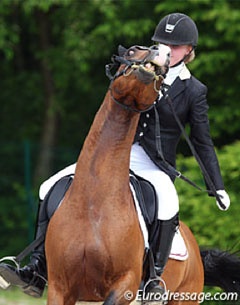
Sometimes we see riders having trouble and, while all of us know what it is suppose to look like, there are days when our horses are tense, tired, or upset about the imaginary gremlins and we have to try our best to stay in control. Having just started competing internationally, I have already personally seen many occasions as well as many videos all across the Facebook of riders giving aids and “supposed disciplinary actions” that for the life of me I cannot understand.
It is unfair for critics to judge riders and horses at international competitions, unless they fully understand what it takes to get a horse to that level. They need to understand what environment the horses are asked to cope with. Sometimes -- and I have been in this situation -- the horse just gets afraid, it's just too much. Even if you want to ride with tact and compassion, self preservation kicks in and you do what you can do stay on.
I understand this and when I watch top pairs who are having trouble and are trying to get back the control of the horse, I can see that by using shoulder-in and small circles and transitions, they can gradually get the horse back listening to their aids. They may need to make a big half halt, or even a strong check on the rein, but they release the moment the horse responds in a positive way and the horse gradually understands the riders requests. This makes sense, it is obvious and clear and the horse understands.
At one of my recent CDI shows, I saw an international rider "disciplining" her horse for a reason and with a method I cannot understand. I was watching a lovely horse trotting towards me and I thought to myself "what a sweet horse, super suspension, lovely rhythm, but above all a look in his eye that said 'yes I’m listening, I will do anything you want me to'.” Just as I was filled with this lovely feeling, the rider hauled on the horses mouth to stop. Then she pulled with all her strength his head around to her left knee, and then again all the way around to her right knee. She spurred him in the guts and trotted off again. Even if I were to comprehend the hauling from side to side, there was no release afterwards to show the horse that anything had been achieved. I started to wonder exactly what the girl was trying to achieve. If I had absolutely no idea what was going on I wondered if the horse would have any idea. Perhaps she felt something I could not see but the punishment certainly did not seem to fit the crime!
I have also seen riders who pull the horse's head right around the the inside and then spur with the outside leg. I can’t for the life of me understand what this is trying to achieve. If perhaps the rider touched with the inside leg it may be some sort of way to get the horse to move away from the leg, or push the quarters, but by pulling the hors'es head and locking him facing the inside and the then spurring him on the outside, all you are doing is create a cage of no escape and then punishing the horse.
Even when a rider is disciplining the horse, shouldn’t the discipline make sense? If I take the rein, or ask for bend and the horse yields, then I give? I should release at the exact moment the horse does what I ask of him. If there is no yielding, no release, then what does the horse learn? Is the message for the horse just that my rider will pull my head all over the place, and whether I do it or I don’t do it, she will spur me and keep going?
I understand that in the big atmosphere horses can be more difficult, but in those moments riders need to pay ten times more attention to their aids and what they are telling the horse. Good riders discipline but release. The message is clear, the horse understands. With no release, even a split second reward, there is no lesson.
It all just confirms for me that horses are amazing animals to put up with the things we humans expect of them. But it would be nice if all riders asked themselves everyday "what's is in this for my horse"?
by Sarah Warne